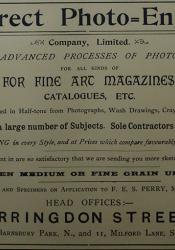Wood Engraving Industry Replaced by Photomechanical Processes
Halftone engraving for tonal images was introduced in illustrated papers and magazines in the late 1880s; Everard Hopkins’s wash drawings for “The Were-Wolf” in Atalanta were reproduced using this technology. By the mid 1890s, line block engraving had largely replaced wood engraving as the standard reproduction technology for linear black-and-white art. All the illustrations in The Yellow Book (1894-1897), for example, were reproduced by this process. As Charles Booth wrote in Life and Labour of the People in London (1902-4): “No other occupation has suffered more than [wood]engraving from the competition of new inventions and the change from ancient to modern methods” (112). Wood engraving firms went bankrupt, and wood engravers lost employment. When Clemence Housman lost her job with Charles Roberts’ firm, she was owed a hundred pounds in wages (L. Housman, “Materials and Notes”). However, thanks to her exceptional skill and her brother Laurence Housman's connections with the Book Beautiful movement, Clemence was able to find work as a wood engraver for publishers of fine books such as The Bodley Head, where Laurence worked as a book designer, and private presses, such as the Essex House and Pear Tree presses.

